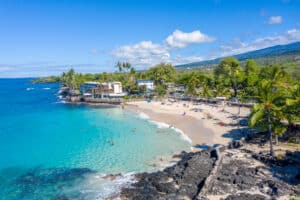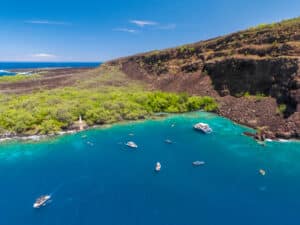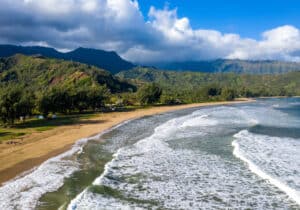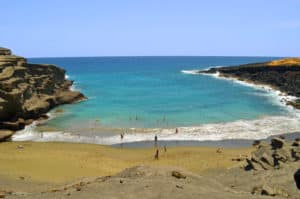The Big Island of Hawaii features fascinatingly diverse geography. Depending on the time of year, it’s possible to go from lounging on a pristine, sun-soaked tropical beach to tossing snowballs on a frosty mountain … in the same day.
There are otherworldly lava fields, lush rainforests, and enough climate zones to produce a wide variety of landscapes.
The Big Island is ever-changing, as well — ongoing volcanic activity literally adds landmass to the island on a regular basis, with hundreds of acres having been added since the early 1980s.
That same volcanic activity is responsible for the Big Island’s colored-sand beaches, the more rare being Hawaii’s green sand beach, the sparkling Papakōlea, one of only four green beaches in the world.
The many names of Hawaii’s Green Sand Beach
Officially known as Papakōlea Beach because of the kōlea bird that frequents the area, Hawaii’s green sand beach goes by many names … including, of course, “Green Sand Beach,” a name which needs no explanation.
Papakōlea Beach is also referred to as Mahana Beach because the geological feature that surrounds it is called Puʻu Mahana. (We’re going with “geological feature” for now because there are differing schools of thought about how, exactly, Puʻu Mahana was formed; more on this later.)
Lastly, some call Papakōlea Beach “Peridot Beach,” a reference to the August birthstone that receives its green color from the same source as Papakōlea Beach’s sand.
What makes Papakōlea Beach’s sand green?
Papakōlea Beach sits inside a cone that scientists generally agree formed more than 49,000 years ago. Up for debate is exactly how the cone formed. Some say Pu‘u Mahana is a littoral cone, formed when magma met ocean, the resulting explosions creating a large cone. Others say that Pu‘u Mahana is a primary vent, through which magma erupted.
In either case, the magma that settled on the inside of the cone contained large amounts of a mineral known as olivine. Olivine is what supplies the green hue to the gemstone peridot, and the mineral is what makes Papakōlea Beach’s sand green.
Following the volcanic event some 49,000 years ago, olivine slowly crystallized inside Pu‘u Mahana and largely remained in place, somewhat trapped by the bay itself and anchored by its own weight while lighter particles were swept into the ocean.
It is illegal to take sand from Hawaii
Let’s get this out of the way, because what makes the sand at Papakōlea Beach so stunning to view and visit also makes it very enticing to pocket and take home.
Don’t do it, and not just because Pele’s Curse could bring you bad luck.
It is illegal to remove sand from Hawaii’s beaches. So even if Pele doesn’t reprimand you, the state of Hawaii very likely will. Fines can reach as high as $100,000. Maybe we should have led with that.
How to get to Papakōlea Beach
Reaching Papakōlea Beach is not particularly easy, requiring both a drive and a hike.
Take South Point Road to the end, driving with caution on this stretch to avoid accidents. This is nearly as far south as you can drive on the island — and in the entire United States! Park at the lot at the end and you’ll see the sign for the Green Sand Beach trailhead.
The hike is 2.5 to 3 miles, rated between moderate and strenuous depending on conditions and your physical abilities. Wear good hiking shoes and bring plenty of water and reef-safe sunscreen; the sun can be particularly harsh here.
The trail takes you south a bit to Kaulana Boat Ramp; from there you’ll trek to the northeast until you reach the beach.
Don’t attempt to drive all the way to the beach, as it is not legal, and avoid fake-shuttle scams from the parking lot.
Safety at Papakōlea Beach
We’ve already mentioned bringing plenty of water and reef-safe sunscreen — the non-reef-safe stuff is banned in Hawaii — as well as the need for good hiking shoes and careful driving, but some of this deserves more explanation.
The sun can be intense here, so cover up or wear plenty of sunscreen, and bring enough to reapply. With intense sun can come significant heat, so make sure you have lots of water to account for 5-6 total miles of hiking sandwiched around your green-sand and surf time at Papakōlea.
Speaking of surf, the waves here can be powerful and unforgiving, and there are no lifeguards on duty. This is far more scenic beach than it is swimming beach, though swimming is certainly possible and many folks do. Exercise caution if you go into the water; good advice anywhere in the islands, but particularly in remote and rough waters like these.







